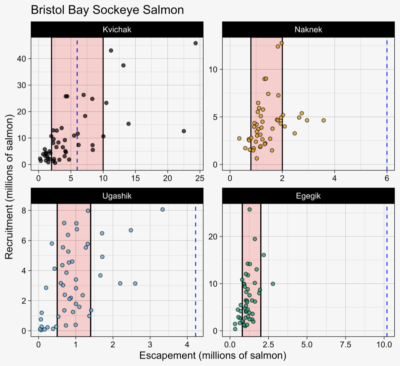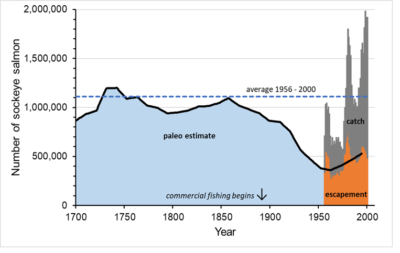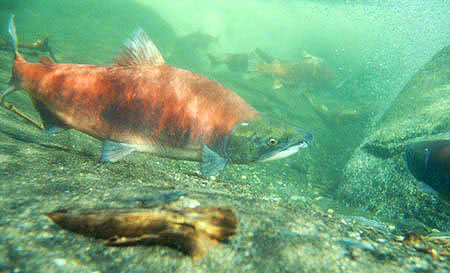The covid-19 public health crisis spreading across the globe is causing economic turmoil in most industries, including fisheries. For Alaska salmon fisheries, covid-19 presents unique challenges that are an immediate threat to the 2020 season.
The seasonal influx of thousands of harvesters and workers from around the world, starting in May, represents a substantial risk for introducing covid-19 to remote communities — where it has yet to be detected, and where people are particularly vulnerable and medical resources are distinctly limited. Further risks are associated with the often crowded conditions aboard fishing vessels and in fish processing facilities that create perfect conditions for the rapid spread of covid-19.
Concern that the Bristol Bay sockeye salmon fishery represents a substantial public health risk has prompted requests for severe restrictions or even complete closure of the fishery until the threat of covid-19 has passed. In addition to the immediate economic impacts of such a policy, these discussions have generated widespread concern about “over-escapement” — that severely restricted fishing would result in spawner abundances (escapements) beyond what watersheds can withstand, thereby severely depressing future salmon production.
Based on data from Bristol Bay sockeye salmon, and current theory about salmon population dynamics, it is clear that concerns for the negative ecological impacts of exceptionally high escapements should be dismissed. Instead, decisions should focus on balancing human health risks and economic impacts.
The term “over-escapement” is used to describe the problems that may arise if too many fish are allowed to migrate into rivers, resulting in competition among these spawning adults and among their offspring, or increasing the spread of disease among salmon. Concern for over-escapement is based on the idea that at high spawning abundances, salmon survival will plummet and the overall production of subsequent generations will be severely depressed.

Figure 1. Relationship between the number of fish in the escapement (spawning abundance) and the resulting recruitment or number of fish that are produced as successful offspring, from that spawning event. Shown are data from 1963 to 2019 (through brood year 2011) for Bristol Bay’s Kvichak, Naknek, Ugashik and Egegik rivers. The current escapement goal ranges are shown as the vertical red stripe in each panel, and the UW preseason forecast for 2020 is noted by the vertical blue dashed line in each panel. Each data point shows escapement in a single year and the corresponding recruitment of fish produced from that spawning event. Data provided by the Alaska Department of Fish & Game.
Fishing, by thinning out the number of fish on the spawning grounds, enhances the total production of salmon stocks (i.e. catch plus escapement) because it weakens the severity of competition among adults on the spawning grounds and among juveniles in nursery lakes.
Inspection of the data collected from Bristol Bay rivers over the last 60 years shows that sockeye salmon populations do not show the extreme levels of competition that lead to substantially depressed future production. In Figure 1 we show four examples of the relationship between the annual escapements (spawning abundance) and the numbers of fish produced from these spawners in subsequent years. Two key patterns are worth noting.
First, the data are noisy, so the relationships are not particularly well defined, as is common for most salmon spawner-recruit data. (Note: In this context, recruitment is the total number of salmon that return in future years — i.e., the offspring — from a single year’s escapement of parents). This scatter in the data reflects the variability in the environments where salmon live, which causes salmon survival to bounce around from year to year.
Second, we can see that high and low levels of recruitment can occur across the broad range of observed spawning escapements. While there is a tendency for higher levels of recruitment to occur at high escapements, and that total recruitment levels off at some point, there is no consistent indication that high escapements lead to greatly depressed recruitment in subsequent generations. This is true even at spawning abundances that are substantially higher than the escapement goals.

Figure 2. Reconstruction of the number of sockeye salmon spawning in a major Bristol Bay nursery lake (Lake Nerka in the Wood River) based on nitrogen isotopes in lake sediments (paleo estimate), compared to the observed catch and escapement to this system from 1956-2000. The decline in the paleo estimates of abundance after ~1900 reflect the development of commercial fisheries that intercepted fish and prevented their contributions to the isotope signal in lake sediments. Catch and escapement data are smoothed with a five-year running average for plotting purposes. The average observed sum of catch and escapement from 1956-2000 is about 1.1 million fish, which is shown as the horizontal dashed line for comparison to the paleo estimates of sockeye abundance back to 1700. Reliable catch and escapement data prior to 1956 are not available.
Another line of evidence demonstrating the lack of scientific support for over-escapement concerns comes from the sedimentary records that lie at the bottom of the lakes where salmon spawn. Here, the mud that accumulates in layers, year after year, holds chemical signatures from dead salmon that are preserved throughout the history of these lakes. By extracting this mud from the lake bottom and estimating the nitrogen isotope signatures backward through time, we can reconstruct how many salmon spawned in these lakes prior to commercial fishing. Figure 2 shows one such example from the Wood River, whose fish are harvested commercially in the Nushagak fishing district.
These prehistorical reconstructions of sockeye salmon from the Wood River and other salmon systems throughout Bristol Bay show that the sustained abundance of salmon prior to the development of commercial fisheries was comparable to the abundance (the sum of catch and escapement) observed over the last few decades.
Conditions in the watersheds prior to the development of commercial fishing are a reasonable surrogate for what they might be if the current Bristol Bay fishery were severely restricted. As can be seen in Figure 2, the numbers of fish produced in the 1700s and early 1800s were comparable to the numbers observed after the commercial fishery developed in Bristol Bay in the late 1800s. We should expect that if over-escapement is a problem now, it would have been a problem then, too, and the numbers of fish should have been depressed in the past. These paleo-data suggest that they were not, and Bristol Bay’s salmon populations were just as productive before commercial harvest began, when virtually all salmon migrated onto the spawning grounds.
Long-term research in Bristol Bay watersheds has demonstrated that there is substantial competition among fish for limited resources. When high escapements occur, it is common to see large numbers of adult fish die prior to spawning. Juvenile salmon also grow more slowly, sometimes delay their migration to the ocean, and have lower survival rates following large escapements, as the lakes have finite capacity to feed many hungry mouths. However, with all the evidence in hand, these mechanisms tend to place an upper limit on how many fish are produced from any river, but not to cause population crashes at high escapements, as the over-escapement argument assumes.
While it is clear that over-escapement is an economic problem — fish that could have been harvested migrate to the spawning grounds where they do not contribute to increasing production in the subsequent generation — the prevailing science does not support the idea that it is an ecological problem that will depress future salmon production.
The collective creativity of our communities is in high gear, developing scenarios and their associated risks for how a fishery might operate without compromising public safety. The social and economic costs of severely restricting the fishery are enormous, and any decision to do so needs to be balanced against the public health risks that fishery operations pose to local communities and fishery participants.
The myth of over-escapement is an unnecessary distraction and should be dropped from these discussions. The fish will be just fine no matter what the outcome is for the 2020 season.







